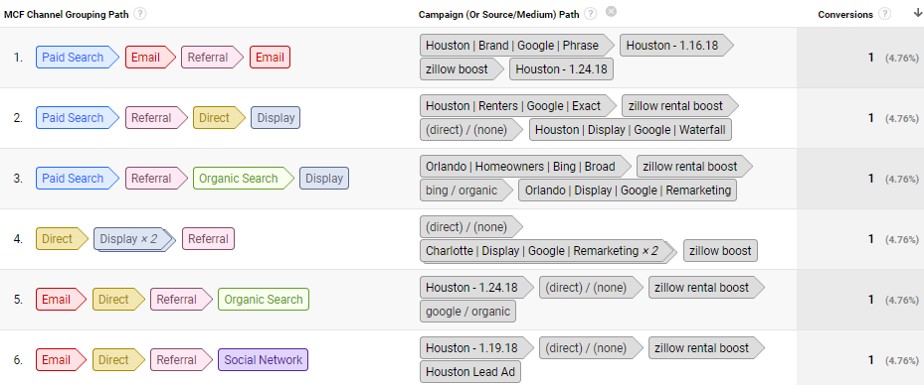Why You Should Adopt a Multi-Touch Marketing Model

May 23, 2018
4 min read
It’s pretty rare for a buyer to see a single ad, decide that’s the builder (or home) for them and stop their search right then and there. Like many other consumers, home shoppers want to be empowered in their decision-making and use a variety of resources to find information about their home.
According to Salesforce, a qualified buyer has been “touched” six to eight times. That might include seeing one of your billboards, visiting your website, engaging on social channels, receiving a direct mail or stopping by a sales center.
But too often marketers credit a single campaign — typically the last one they ran — with converting most of the leads they receive. This is considered a last-interaction attribution model, where the last touch point receives 100 percent of the credit for the sale or conversion. And as savvy marketers know, a home shopper’s search can take weeks — even months — so the campaign you attribute the conversion to may not even be the one that sealed the deal.
This is frequently the case with last-touch marketing models. You might never learn how buyers first heard about you, which campaigns most of them come through, how many times you reach them, how long their search takes and more valuable data. Think about all those unopened emails, discarded direct mail pieces or unseen billboards — messages sent but not always received before a buyer converts.
So, how do you know which marketing efforts work and which ones don’t? How do you draw a direct line between your communications and your conversions?
By diversifying your marketing strategy — adopting an attribution model that includes multiple touch points to help you:
- Reach more home shoppers.
- Identify the campaign(s) that helped them find you.
- Understand behavioral trends that convert them to buyers.
Here’s how to do it.
Connect and sync your data
The first step is to connect all your data sources — your customer relationship management (CRM) system info, website analytics, sales center feedback, social media engagement, paid search, email, etc. — and sync them to eliminate inaccuracies and redundancies. This step consolidates all your information into a single system and ensures your team uses the same methods to generate consistent and reliable data.
Connecting and syncing your data allows you to track all the touch points your home shopper audience will encounter before they convert to a buyer.
Identify your model
Your second step is to identify a multi-touch attribution model that quantifies each touch point’s impact. There are three primary multi-touch models that, after a conversion, assign a different credit percentage (or weight) to a touch point, depending on where that touch point occurs in the campaign.
Example campaign

Even/linear
In the even or linear model, each touch point in the campaign (or path to conversion) gets equal credit for the conversion. For example, if campaign A included paid search, email, social networking and referral touch points, each would get 25 percent of the credit for a converted home shopper in that campaign.
Time decay
In the time decay model, the touch point that occurs closest to the conversion gets the bulk of the credit. In the campaign A example, run in order, the referral touch point would get the most credit for the conversion. Social networking and email would get less credit, and paid search would get minimal, if any, credit.
Position-based
In the position-based model, 40 percent of the credit is given to the first and last touch points. Again, using campaign A, this would be the paid search and referral touch points. The remaining 20 percent of the credit goes to the middle touch points (email and social networking).
Which weighted model is right for your business? Start with the even/linear model, which will give you an initial sense of which campaigns generate more conversions versus non-conversions.
Then, when you start to identify conversions that are more associated with time decay or position-based touch points, switch your model. And when your campaigns start generating clear patterns of success, you can adjust your touch points accordingly.
Multi-touch marketing in action
We spoke with Aryan Moharir, director of digital strategy and analytics for LGI Homes, about his approach to multi-channel marketing.
“Adopting a multi-channel attribution model enables us to maximize the efficiency of our budget,” said Moharir. “Essentially, this strategy takes the guesswork out of how we should be allocating our resources across digital advertising channels by weighting the distribution across all touch points — as opposed to a traditional last-click attribution model.”
By appropriately tagging links and setting up channels in Google Analytics, Moharir can clearly see the consumer path to conversion.
The Google Analytics example below demonstrates how nearly all of LGI Home’s conversions included at least four touch points. In Campaign 1, the company started with paid search on Google, then an email campaign, referral traffic from a Zillow Boost campaign and another email before buyers converted.

This information shows Moharir which channels perform, which don’t and the number of touch points his target buyers need before they convert.
Analyze your results
The final step in adopting a multi-touch model is analysis. This critical step shows you what’s working and what isn’t. Even more importantly, consistent and ongoing analysis will reveal how much each campaign and touch point is working so you can effectively manage your marketing budget.
But constant improvement is never done. Markets shift, platforms change and home buyer needs evolve over time. Once you master tracking and analyzing your data, look for blips and patterns, and adjust your multi-touch model as needed. Conduct surveys, test and retest your campaigns, and always investigate new ways to improve your reach and engagement with home shoppers so you can convert them to buyers.
Continue reading our marketing attribution series:
Builders, meet buyers.
82 percent of prospective buyers consider new construction.* Make it easy for them to find you – list where they’re looking.
*Zillow New Construction Consumer Housing Trends Report 2025
Learn More